One of the questions that arises in conjunction not only with homelessness, but with the increased cost of housing, has to do with areas that are considered “public” zones, and with the layout of cities. Because as people become homeless, they have to “be” somewhere, and, particularly if the city/state or federal government has not provided them a designated place to go, generally this means they are sleeping and/or setting up a camp in some public area — eg on some public property. Often those who have little but a sleeping bag, shopping cart and some found objects to create a shelter, will set up their camps in lesser used parks, or on street medians or sidewalks in industrial areas or commerical areas of the city. 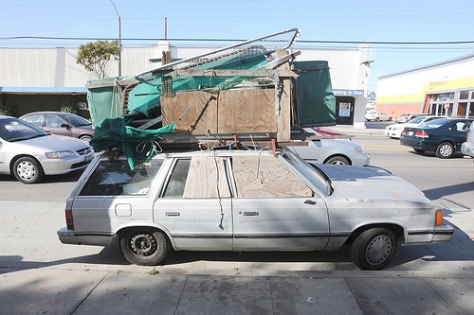
However, there are a good number of people who in a sense are not actually “homeless” –because they live in their vehicles. Sometimes this is by choice, and sometimes the vehicles are quite elaborate, even very well appointed and well suited for living in. Many live in vans and RV’s, and sometimes the only thing differentiating the well-off retired couple who lives in their RV and travels around the country, from the indigent who lives in his RV, is the location of the RV. The retirees park their RV in a campground or WalMart parking lot, or in rural areas on the side of the road during their travels — rarely on residential city streets. The latter are not generally found in fee campgrounds, are less likely to spend much time far from cities where they obtain free services, and live primarily on public streets. 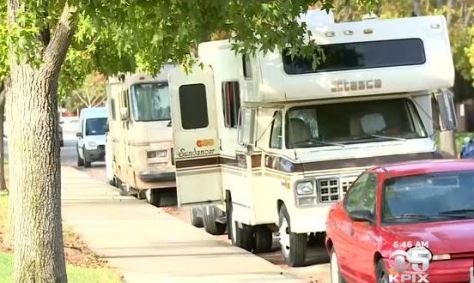
Given that living in a vehicle affords more privacy, more comfort and more security than living on the sidewalk or under a freeway overpass, it is not surprising that many people would prefer to live in a vehicle if they have one. It is also likely that given the choice between living in a vehicle on a public street, and living in a homeless shelter or navigation center, many would choose the former. In other words, even if a city had space in shelters for every single homeless person in city limits, some of those would refuse the shelter to stay in their vehicle on the streets.
Which brings us to the question about how this phenomenon of people living in vehicles on public streets is impacting cities and area residents. For the most part, I’ve observed that those living in vehicles tend to do this in more “out of the way” areas, such as commercial-industrial areas, in or near city parks, or on streets where they are not directly in front of someone’s home. However, as the number of people living in vehicles increases, and as such campers feel more justified and entitled to live on the public streets, more of them may do this in areas where this creates more problems for city residents — such as adjacent to schools or parks where mothers take small children, or even directly in front of other’s homes. I have found some residential neighborhood streets in Berkeley and Oakland — some of them quite nice upscale neighborhoods — where there are 4 to 8 people living in vehicles on one block. One such area was along Santa Fe Avenue just near the park which runs under the BART train tracks and the Ohlone Bike path. I used to see about 6-8 RV’s parked on that street, several all in a line, one behind the other, next to the grassy area. 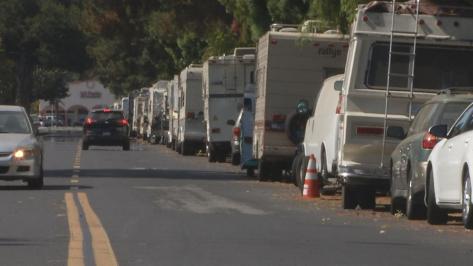
Living in an urban area with a significant population of homeless/indigent individuals, I like many others have have had homeless people sometimes living in their vehicle directly in front of my house. Immediately in front of my house it’s occasional only, but just a little ways down the street from me, the problem is worse and some residents have had 2-3 homeless people living in their vans just in front of their homes, every night, for over a year now. (The same people and same cars for over a year…who are clearly regarding this section of public street as their permanent home). These are blighted direlect-appearing vehicles whose windows are entirely covered with rags and/or tin foil, visually striking in this relatively well-off neighborhood which sports few old cars of any type. I am afraid this problem could migrate more in my direction. It’s hard for me to understand why someone would choose to do this, since they have so many other options — there is no dearth of places to park which are NOT right in front of someone’s home — and so the choice to do so seems particularly obnoxious, as well as unsettling.
When people living in their vehicles park right in front of my house, I experience it as rather invasive. As with many old houses in urban areas, my house is very close to the street. In fact there is less distance from the front bedroom of my house to the street/curb, than from that same bedroom to my own bathroom. The streets were never intended as public campgrounds, and city planning and zoning laws exist such that when people buy or rent a home, they have a right to depend on such regulations to protect their space from encroachment or invasion, allowing them to expect that what they’ve purchased or rented will not be subject to the sort of significant alteration that would occur if someone else could simply set up a permanent camping spot 20 feet from their bedroom window. My neighbor would not be allowed to build a tiny house in his front yard, hard on the property line, and yet the same result occurs when someone simply drives up and parks their RV dwelling in front of my home and stays there for a night or more. I suddenly have a neighbor, much much closer than the city laws or zoning would permit one to reside; and yet, because this neighbor is deemed “homeless” and living in a vehicle, they seem to be exempted from all the regulations which would prohibit such encroachment in any other way.
In fact I think it’s often misleading to call people “homeless” if they are living in a vehicle, particularly if it’s an RV or van well set up for the purpose and/or they’ve been doing it for some time. The vehicle is their home, their residence, and by the mere dint of the fact that it’s a residence on wheels —and whether it’s a compact car or an enormous, expensive posh RV — apparently they now get far more rights about where they can locate their residence, than anyone else without wheels would be able to obtain.
In addition to the issue of sheer invasiveness of setting up your residence 20 ft from someone else’s bedroom, there is the massive size of RV’s that is an issue in and of itself. 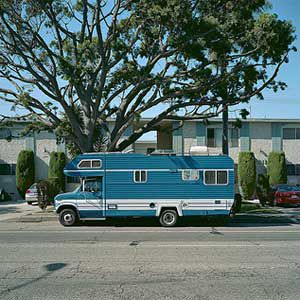 Because an RV parked in front of a house so significantly changes the view, as well as the “feng shui” of that place, many cities have laws which prohibit RV’s from being parked anywhere on public streets. An RV parked in front of a house, particularly a low house built on a slab foundation, in essence suddenly places a huge 20-30 ft long and 10 ft high wall in front of that house. It makes it impossible to look out the window and see anything but this RV/wall, and so its enormous presence is overbearing as well as ugly. Berkeley does actually have a law (BMC section 14.40.120) prohibiting parking any oversize vehicle on any city street, from 2am to 5am, for more than one hour. Whether this law is adequately enforced, is another issue.
Because an RV parked in front of a house so significantly changes the view, as well as the “feng shui” of that place, many cities have laws which prohibit RV’s from being parked anywhere on public streets. An RV parked in front of a house, particularly a low house built on a slab foundation, in essence suddenly places a huge 20-30 ft long and 10 ft high wall in front of that house. It makes it impossible to look out the window and see anything but this RV/wall, and so its enormous presence is overbearing as well as ugly. Berkeley does actually have a law (BMC section 14.40.120) prohibiting parking any oversize vehicle on any city street, from 2am to 5am, for more than one hour. Whether this law is adequately enforced, is another issue.  Many other cities have similar laws. In this article: http://takebacksantacruz.org/yes-to-rv-parking-restrictions/ created for advocacy on the issue by residents in Santa Cruz who were fed up with RVs parking on public streets all over their city, it’s stated that 46 cities on the California Coast have RV parking restrictions. Of those 46 cities, the article states, “76% of those cities do not allow the parking of a recreational vehicle at ANY TIME with the exception of permits obtained by city residents for TEMPORARY parking only. ”
Many other cities have similar laws. In this article: http://takebacksantacruz.org/yes-to-rv-parking-restrictions/ created for advocacy on the issue by residents in Santa Cruz who were fed up with RVs parking on public streets all over their city, it’s stated that 46 cities on the California Coast have RV parking restrictions. Of those 46 cities, the article states, “76% of those cities do not allow the parking of a recreational vehicle at ANY TIME with the exception of permits obtained by city residents for TEMPORARY parking only. ”
El Cerrito prohibits oversized vehicles 20 ft or longer including RVs from parking more than one hour on any street between 2am and 6am. For instance, in Redwood City as well as in San Rafael it is prohibited to park an RV on any public street for more than 1 hour. The city of Santa Barbara prohibits such parking. The city of Whittier recently moved to prohibit RV parking on its streets. The city of Carlsbad as well as the city of San Marcos prohibit RVs parking on city streets from 2am to 5am. The city of Santa Monica prohibition is for large vehicles, which covers both RVs as well as big rigs or other large trucks or rigs that would have the same overwhelming and negative effect if parked in front of someone’s home. The city of San Mateo restricts RV parking , while the city of Albany prohibits oversized vehicles, including RVs, from parking on any public street in the entire city of Albany. Union City prohibits the parking of oversized vehicles, including RVs, of 20 ft or longer on city streets at any time. San Leandro prohibits oversize vehicles 20 ft or longer, which would include RVs, from parking on residential streets between 2am to 6am. THe city of Orinda prohibits living in vehicles, and prohibits oversized vehicles (20 ft or longer, including RVs) from parking on residential streets at any time, and from parking on any city street at all from 2am to 6am. Alameda also completely prohibits RVs on any city street in Alameda, although a temporary permit to park an RV for 24 hrs only is available. Eureka prohibits RVs and any vehicle over 20 ft in length from parking on city streets overnight. In Ventura, anyone wanting to park a vehicle over 25 ft long or 82 inches high must apply for a permit to do so. In San Diego, RVs cannot be parked on any city street from 2am to 6am, unless they get a permit, which is good for only 24 hrs. The city of Chula Vista prohibits RVs on the street at any time. (See code here) In South San Francisco, vehicles over 22 ft long or over 8.5 ft high are not allowed to be parked on residential streets. In Pacifica, only RVs owned by homeowners are permitted to be parked on city streets. Olympia Washington prohibits RVs on city streets from 3am to 6am. 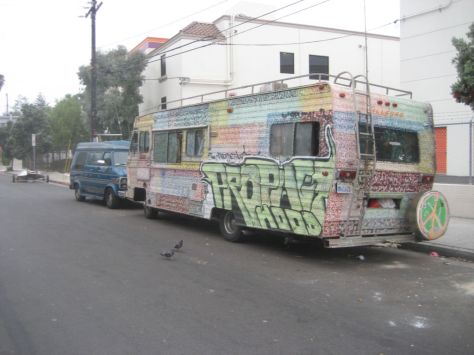
In Berkeley, vehicles over 20 ft long or over 6.5 ft wide may not park on any city street for more than an hour between 2am and 5am. 
Oakland prohibits commerical vehicles over 10,000 lbs on residential streets.
Oakland also has a law prohibiting RV parking on public streets — but oddly the prohibition seems entirely directed at homeowners, as opposed to anyone else. This page which summarizes Oakland’s blight ordinance states, significantly, that “Recreational vehicles, boats and trailers can only be parked on your property in a fully enclosed garage. ”
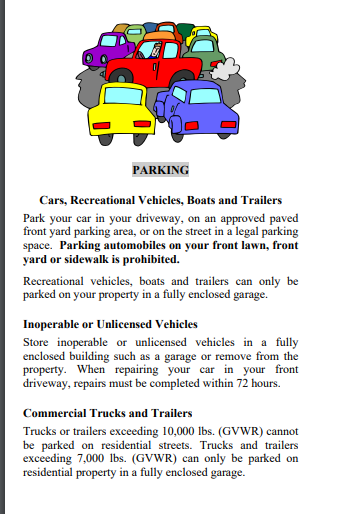
This blight law is particularly contradictory, since, as I’ll indicate below, the city of Oakland now allows anyone to live in a vehicle (any vehicle, including an RV) anywhere on any public street. This in spite of the fact that there are other laws in Oakland which prohibit or restrict the parking of oversize vehicles on residential streets, such as this law pertaining to R-1 Residential districts.
 So on one hand the city is saying to homeless people and indigents (or really anyone of any income level who so chooses) that they can live in a vehicle on the public streets, while on the other hand they’re telling homeowners that they can’t park their own RV on the public street in front of their own home. These two statements either contradict each other completely or indicate that non-homeowners have more “rights” to use of the public streets than homeowners do. Neither of these conclusions is acceptable.
So on one hand the city is saying to homeless people and indigents (or really anyone of any income level who so chooses) that they can live in a vehicle on the public streets, while on the other hand they’re telling homeowners that they can’t park their own RV on the public street in front of their own home. These two statements either contradict each other completely or indicate that non-homeowners have more “rights” to use of the public streets than homeowners do. Neither of these conclusions is acceptable.
However in spite of the stated blight law, it appears that Oakland may not be enforcing it. This neighborhood discussion reveals that the city refused to take action about a “huge RV” parked in the same spot partially on a sidewalk, in spite of numerous complaints, and in spite of the fact that the RV had expired registration (itself an issue that can easily result in the vehcile being towed away) , was parked over 72 hrs in one spot, was partially parked on the sidewalk, and was parked in a place that violated the city’s own stated blight laws.
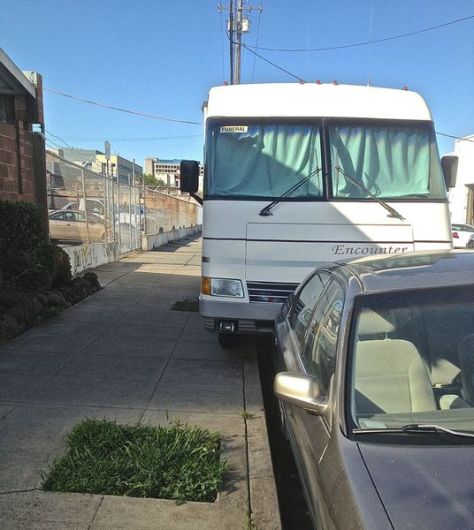

What are the laws about living in vehicles on public streets?
Intitially, many cities prohibited people living in vehicles on public streets. However, such laws were often problematically vague, and could have an unintended result of criminalizing people who simply “lived out of ” their vehicles, or who were traveling and needing a break, and slept in their vehicles for a short time. It was as a result of such vagueness in a Los Angeles law, that the Ninth Circuit Court of Appeals ruled in 2014 that blanket city prohibitions on living in vehicles anywhere in the city are be unconstitutional. See the court decision here:
Court Ruling on People living in vehicles in LA
 The city of LA provides maps like this one, where the streets in red are areas where it is not allowed to park and live inside one’s vehicle. The following language of the ordinance creates separate regions where one or another of these regulations apply.
The city of LA provides maps like this one, where the streets in red are areas where it is not allowed to park and live inside one’s vehicle. The following language of the ordinance creates separate regions where one or another of these regulations apply.
 The law was viewed as unconstitutionally vague . The problem was particularly acute in Venice CA as this news article shows.
The law was viewed as unconstitutionally vague . The problem was particularly acute in Venice CA as this news article shows.
Los Angeles responded to this court ruling in a sensible way — as this article indicates, it prohibited people living in vehicles in residential areas, but allowed them to do so in commercial and industrial areas. However, the problems associated with an increasing number of RVs are now occurring in commercial and industrial areas, as indicated in this March 18 2018 article, and so Los Angeles is closing down more streets to RVs and vehicle dwellers as complaints about blight, nuisance, garbage, theft, and sewage dumped in the street are escalating. Ultimately, cities need to face the fact that people living in tents or cars is something that needs to be regulated and done in sanctioned areas only, in some type of parking lot or campground, or quasi-refugee camp, overseen by city employees and security guards.
Other cities have not taken the approach of Los Angeles, and are simply refusing to enforce any laws against living in vehicles, regardless where the person is living — either on a residential or commercial/industrial street. By failing to create any reasonable regulations on the matter, cities have deprived themselves of the only truly effective tool they had to use to prevent what is really completely unacceptable– people driving right up and living in their vehicle in front of your house or mine, really for as long as they like. Parking restrictions alone cannot prevent this problem.
Even so, some US cities still prohibit people living in their vehicles in the city. For instance, Beaverton OR recently passed a law prohibiting this, as this article reports. 
Some people have said, “Well if it bothers you to have someone in an RV in front of your house, why dont’ you ask them to move?” That’s a nice sentiment but rather naive. The last couple times I spoke nicely to someone asking them not to camp on the street in front of my house, I received threats and also garbage dumped in front of my house for about a month afterwards. Other possibilities for those angered by such polite requests would be that we find our cars vandalized, plants ripped out of our yards, and more. If the law — as it should — actually prohibited people camping in vehicles at least in certain areas (such as in residential areas), individuals doing that would not be so bold as to threaten others for complaining about it. However since there is now no law on our side, there’s little to prevent people from first being obnoxious and then hostile and/or aggressive towards anyone who entreats them to find a more suitable camping spot.
Here’s another story about someone who struggled for over a year with someone living in an RV in front of his house:
https://patch.com/california/eaglerock/fed-up-of-rvs-parked-on-your-street-some-activism-may-help
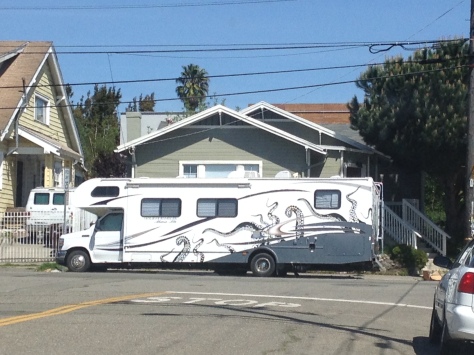
What it looks like when a giant RV parks in front of your house — Oakland CA April 2018
In other municipalities, advocates for the homeless are fighting against laws that would regulate people living in vehicles on the streets. For instance, in San Diego.
Homeless sue San Diego over parking laws
This site shows a register of actions on this lawsuit.
Thus the advocates for the homeless are unfortunately advocating for nonregulation on the issue, a situation which harms neighborhoods by allowing streets to be turned into campgrounds. Reading the complaint, it is clear that the plaintiffs have few good options and need to live in their vehicles if they remain in the San Diego area. It seems to me that San Diego could easily create parking lots specifically for such people, while also assisting them to find someplace to live in the nation (not necessarily in San Diego or California). Creating specific places for these people to live in their vehicles would both solve the problem of people living in cars on public streets, while also protecting vehicle dwellers from the insecurity and anxiety about being ticketed.
To argue, as the legal complaint does, that it’s a form of cruel and unusual punishment, or violation of due process (8th and 14th Amendment issues) to fine people more than they can afford to pay, is an argument that could, by extension, result in no poor person ever having to pay any fines, and thus essentially exempt a large class of people from the obligation to follow the same laws as everyone else. While it makes sense that the government should not be able to take someone’s home away from them (tow and impound a vehicle they are living in) if they can’t pay the fine, it is not acceptable that the only alternative would be to stand passively and watch helplessly as public streets are turned into squalid campgrounds. Somehow there has to be a way to protect people on both sides: the poor who live in vehicles, and the neighborhoods which dont’ want their streets turned into campgrounds. It should not be hard to solve this problem.
Many cities, including most of those in the Bay Area, have now backed down from their laws prohibiting living in vehicles, and are thus allowing anyone so motivated (not only the “homeless” but anyone who chooses to live in a vehicle) to exploit this rollback of the law and turn “parking” into camping, and streets into campgrounds. I’ve spoken to police officers in both Berkeley and Oakland, and have been told directly that the police cannot and will not enforce “no camping in vehicle” laws, so that the only recourse anyone has, if someone is living in a vehicle in front of their house, is to use parking laws to deal with the situation. Using parking laws alone to try to deal with the nuisance, blight, and invasiveness of people living in their vehicles in residential areas, or right in front of your house, is extremely ineffective, particularly in Oakland.
In Berkeley, where there are more resources to attend to the problem, police will mark the vehicles and check them to ensure that as the law requires, the vehicle is moved very 72 hrs. One reason for this law (which is common throughout the state ) is that if the public streets became filled with nonoperative vehicles, the amount of parking available for those who drove regularly and needed a space to park might be significantly reduced. Another reason is to reduce blight: if there were no way to remove nonoperative broken down junk from the street, the streets could much more easily become seriously blighted.
However, though most all cities have this ordinance prohibiting parking in one spot for more than 72 hrs, (and in Berkeley it is enforced, when a complaint is received) I recently discovered that in Oakland, the city is all but unable to enforce this law. 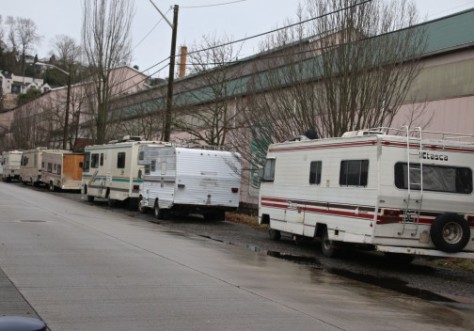
See these scanned copies of emails from Oakland’s Abandoned Auto Detail, which processes complaints about cars parked over 72 hrs. In May 2016, their automated email response to such complaints, stated that they would process the complaint within 10 business days.
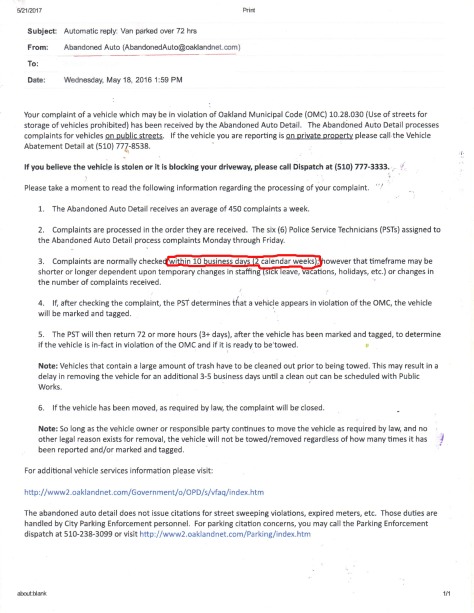
In February, 2017, the time period the same department required to process complaints increased to 15 days:
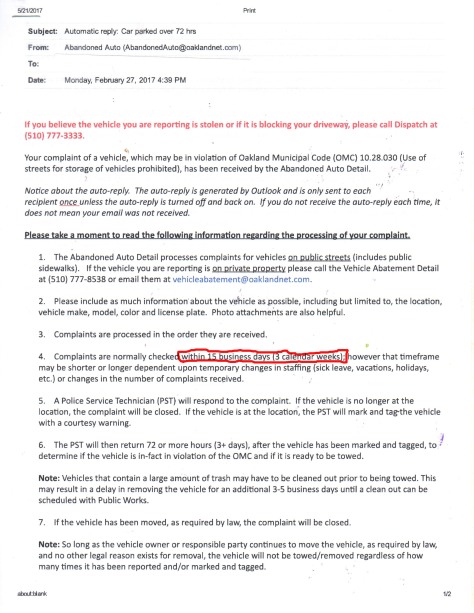
While by April 2017, the same department now stated it would require up to 20 days to process complaints for this 3 day parking limit:
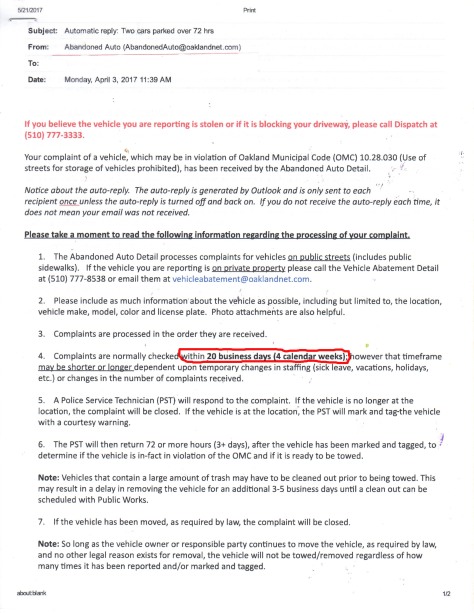
I’ve rarely had cause to file a complaint/report with the city over a vehicle parked over 72 hrs in the street in Oakland, but have done so a few times. Recently, I called in to report about a vehicle that appeared to have been abandoned on a street near my house, a street which is partially in Berkeley and partially in Oakland.
Parking on the street near my house is a 2 hr zone, such that those without residential parking permits aren’t allowed to park more than 2 hrs. This vehicle had no permit and had been parked in this same spot in the Oakland part of the street near my house for quite a while, and appeared direlect — perhaps a stolen vehicle I thought (one important reason to report vehicles parked for a long time in one spot, is that if they are stolen, the owner will be more quickly reunited with the vehicle if it’s reported). I called to file a report about it being parked over 72 hrs. It took over 20 days for the city even to mark the vehicle. The car remained in that spot for over 25 days after the date I reported it (before which it had already been there a good while) and in that time only received one ticket for being parked over 2 hrs in the 2 hr zone. Eventually I believe the vehicle owner moved the car, because I saw it elsewhere.
Another time, I saw a car that had been parked several weeks in an area in Oakland where illegal dumping is common. Someone had actually dumped a huge pile of trash right up against that car. I called the city to report the car parked over 72 hrs, and a month later (over 30 days later), the city had taken no action at all, they had not even marked the car. So I phoned in to ask the city about their enforcement for this law, and to point out that it’s hardly effective if you have a law prohibiting parking over 3 days but can’t even enforce it within a timeframe of 30 days. I was incredulous at what the staffperson at the City of Oakland told me. He said that this problem of abandoned autos on the streets of Oakland is a HUGE problem for Oakland, and that they just dont’ have the staff to deal with it. He also stated that because some neighbors use this law to harass each other, (“and the police know it” he said), he told me that the city now refuses to tow vehicles parked over 72 hrs in one spot, if the owner of the vehicle lives in that general area.
What concerned me is that this in essence means that the city has no effective means to deal with any random person who happened to decide that they wanted to live in their vehicle in front of your house. The laws prohibiting living in vehicles in public streets have been suspended, in light of the Ninth Circuit Court ruling, and cities apparently haven’t bothered to or cared to draft new replacement laws which would be acceptable to the court. Absent any other parking restrictions, that has left only the 72 hr parking law as a very weak means of dealing with people living in vehicles on the streets, and now in Oakland that law is very weakly enforced overall, and appears to be not enforced at all if the vehicle owner has a local address.
Particularly for those residents who live in neighborhoods that attract the vehicle dwellers, this lack of enforcement could amount to serious problems at some point.
So as I see it, there is a need not only to provide more homeless shelters and housing, and to create designated areas for car camping — but also for neighborhood residents to “take back the streets” and demand that cities do more to protect neighborhoods from nuisance, blight, crime and the inappropriate encroachment of other’s residential dwellings upon their own.

Particularly given the rising cost of housing, it’s important to realize that not everyone who lives in a vehicle is “homeless” and/or indigent. Some people live in vehicles by choice — for instance, I recently met a man who formerly lived in a less expensive Bay Area “bedroom community” , but decided that he’d rather live in Berkeley, which he could not afford. Rather than remain in housing in a place where he could afford housing, he decided to live in an RV in a place where he could not afford to live. He bought an RV, and is now living in the RV on public streets in Berkeley. He told me that he primarily parks in industrial areas but sometimes in residential ones, and sometimes right in front of someone else’s house. He seemed offended when he encountered people — like the woman in front of whose house he parked who called police to mark his RV for 72 hr parking — who were upset about this — declaring “I have a right to park in the public streets!” However, he’s being disingenous about what he is doing in the public streets, because he most definitely is not just PARKING there. He’s LIVING there. There’s a big difference, but unfortunately the law is at a point where it’s unable to make distinctions in these two things. And if he has a right to park and live in public streets, what about the right of a house dweller not to have her space suddenly invaded, her view blocked by a humongous RV? Her right not to have a person suddenly “move in” and reside in a space that was never intended for residence, and should not be permitted to become anyone’s residence?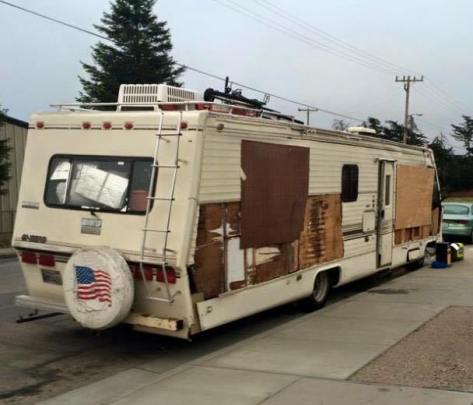
In addition, the phenomenon of living in vehicles is growing, and articles on this issue demonstrate that it’s not just “the homeless” who are living in vehicles. An increasing number of folks are living in vehicles “by choice”, as an alternative to high housing costs.
Which is the theme of this San Francisco Chronicle article —
And this one —
And this one —
And these articles:
https://www.mercurynews.com/2017/08/03/meet-some-of-the-people-who-live-on-the-streets-in-rvs/
The line at the end of the SF Chronicle article supports the fact that many of these people are not really homeless…
Said Ravanelli, “I’m not homeless, I’m houseless by choice.”
Many van and RV dwellers are claiming that vehicle dwelling is a viable choice, a viable alternative to paying rent.
Barbara Wahli, 46, considers herself a part-time RV lifer. She purchased an RV last year and quickly found herself enmeshed in a diverse community of part-timers, like her, and full-timers, like Ollie and Andreas. The group is a diverse one; incomes range far-and-wide, as do ages. But they’re united by a common desire to skirt the high cost of Bay Area life.
Many of Wahli’s friends make “pretty decent money,” she said. “They’re not doing it because they’re broke or homeless, but because they don’t understand why they should be paying so much rent.”
Jason Ravanelli, 51, falls under such a designation. He’s lived in the Bay Area his entire life and currently rents an Alameda studio for $1,500 a month. When his son graduates from high school this year, he’s moving out and into a van.
“I have to live and work here because I have no resources to go elsewhere,” said Ravanelli, a logistics manager for a truck company in San Francisco. He hopes living in a van, rent-free, changes that.
A recent study in San Francisco, found that 80 percent of those living in vehicles on city streets in San Francisco, did not want help getting permanent housing.
Eight out of 10 people living in cars and RVs in San Francisco don’t appear interested in moving into permanent housing, and only half of the car campers want help from city programs, according to survey by the Department of Homelessness and Supportive Housing.
“Half of the people in the cars and RVs don’t want our services,” said city homeless czar Jeff Kositsky.
And therein lies one of the biggest challenges facing San Francisco and other cities dealing with a growing number of curbside campers.
Cities need to get smart — stop fooling yourselves that all the homeless want is housing. No, a great number of them don’t want housing. They want to homestead on public land. And until you really understand that and create laws and provide enforcement to stop this, you’re enabling people grabbing public places and resources away from all of us, allowing people to turn streets not just into campgrounds, but into permanent private homesteads.
Many of these vehicle dwellers are attempting “stealth camping” or living “discreetly” on urban streets. However as the number of people living in vehicles on city streets increases, this “stealth” aspect is likely to deteriorate into blatant in your face turning city streets into campgrounds — which has already happened in many, many areas.
“I’ve got internet, TV, a phone, fans, ventilation,” said 37-year-old Pauly Ollie of his cargo van setup. “It’s just like a tiny home.”
Ollie’s mobile home is discrete [sic]: He drives a cargo van, with a hand-built trailer attachment, that meshes with the patchwork of San Francisco’s streets. At night, he parks in dense urban areas, where a foreign van won’t raise eyebrows, but he’s not about to publicly reveal the prime locations.
Though many tout vehicle-dwelling as an “off the grid” phenomenon, and take pride in the “stealth” nature of living in vehicles in urban areas, as this map below of homeless camps and vehicle dwellers in the Berkeley area shows, there is a growing problem in urban areas. This image shows clearly that this phenomenon has a significant impact on cities and neighborhoods. There are many cities where (in the flatlands at least, as in Berkeley) you can hardly walk 5 blocks in any direction without encountering one or more people living in their vehicles, and you may encounter 10 or 20 of them within 5 blocks.
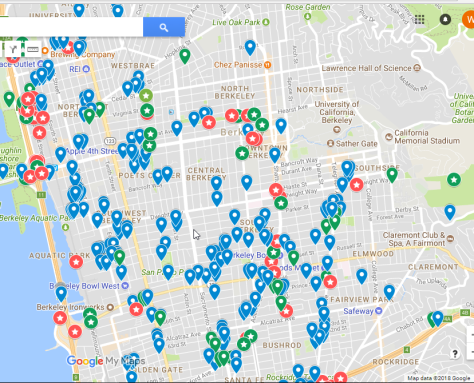
See more about this map on this article:
https://homelessquandary.wordpress.com/2017/11/24/map-of-homelessness-in-berkeley/
Given the very large proportion of homeless who have substance abuse, or serious mental illness (a Berkeley study showed that 40% of all homeless have one or both of these problems), and given the fact that some homeless and indigent turn to crime in order to support themselves (particularly if they see few others options), the “homeless” person living in a van or RV on public streets, or even in front of your home, could be a drug addict, mentally ill person engaging in bizarre behavior, or even a criminal. In San Francisco in February 2018, police ended up arresting someone living in an RV on city streets, in connection with a shooting incident which left one person dead and one gravely injured. The person being investigated as the perpetrator of this crime is a homeless person living in SF.
The San Francisco Police Department arrested 31-year-old Joel Armstrong and charged him with murder, attempted murder, carjacking, possessing a firearm as a felon and receiving or possessing stolen property. Armstrong was identified by police as a transient.
In another case in Garden Grove, CA, one of 3 homeless people found dead inside a van on March 16 2018, was a man with a long criminal record.
A homeless man found dead with three others in a parked van outside a Southern California strip mall had a lengthy criminal history, including convictions for conspiracy to murder and child abuse, authorities said Saturday.
Phunyouphone Kanyavong, a woman believed to be his girlfriend and their two young children were found dead in their pajamas Thursday night inside a van with blankets covering the windows in the city of Garden Grove, police said.
The cause of their deaths is under investigation, but with no signs of obvious trauma, police Lt. Carl Whitney said authorities suspect carbon monoxide poisoning.
Even if the vehicle dwellers are “regular people” without such issues, there is a limit as to what extent cities can turn a blind eye to the turning of public streets into campgrounds, without deleterious effects on neighborhoods. It seems very common sensical that there should be areas where car camping is permitted and areas where it is not permitted. This would not be hard for any municipality to regulate and it would go a long way towards protecting communities.
Even some of the vehicle dwellers themselves realize it’s a problem when RV campers simply park in one spot and never leave:
“There’s families who live in RVs now that just don’t leave,” Wahli said, citing Shoreline Avenue, which has a large population of formerly homeless people living in RVs.
“You can’t just park somewhere and stay,” she continued. “They’re ruining it for everyone.”
Even in her “upper class” Campbell neighborhood Wahli routinely sees a cohort of mobile homes. They move around every few days, she says, but “they are always there, and that’s a problem.”
In July 2017, Palo Alto took a common sense step and began using the state’s 72 hr parking ordinance (which, statewide, restricts anyone from parking more than 72 hrs in one spot) to remove vehicle dwellers living in RVs from a street where their presence had obtained a large number of complaints.
The city of Los Angeles was the place where a major Federal Circuit Court decision came down, which made it more difficult for cities to deal with the problem of vehicle dwellers in the city. Los Angeles had had a law which prohibited people living in vehicles in city limits. An attorney representing the homeless living in vehicles sued the city over this law, and a Federal Circuit Court judged in their favor, striking down the Los Angeles Law. However, whereas Berkeley and Oakland and perhaps other cities have used this court decision to justify their now taking an almost completely passive approach to this problem, and refusing to do anything to rein in the problem, Los Angeles did not respond to the court decision so stupidly. Clearly, a court decision that prohibits a complete ban on vehicle dwelling is not the same as a prohibition on any restrictions on vehicle dwelling in the city. So Los Angeles then passed a law which prohibits living in vehicles in residential neighborhoods, but allows this in commercial and industrial areas. This seems a very reasonable and common sensical first step and I can’t understand why Berkeley and Oakland would not move to take the same step. These articles describe LA’s approach:
http://www.latimes.com/opinion/livable-city/la-oe-gapay-dont-roust-homeless-in-vehicles-help-them-20170216-story.html
http://www.thetruthaboutcars.com/2017/01/los-angeles-is-attempting-to-fix-its-homeless-car-parking-problem/
http://www.scpr.org/news/2017/02/06/68713/new-restrictions-limit-where-homeless-in-cars-can/
It will continually be my goal to look not just at the “rights” of those who we deem less fortunate, but also the rights of traditionally housed city residents, whose neighborhoods are effected in many negative ways by homelessness as well as people disrespecting the space around other’s homes, who insist that they have a right to house themselves on the public street directly in front of someone else’s home. The Quandary of Homelessness cannot be accurately and adequately perceived and explored without looking at these issues from both sides and considering the needs and rights of all those involved.
What do I recommend as a way to solve this problem?
As expressed elsewhere, I believe that the solution to these issues must involve both providing adequate shelter space and housing to those in need, as well as then prohibiting people from setting up camps in any random place they might choose. To me the key issue in all of this, is that shelters, housing and space for a variety of types of camping, must be in designated areas only. Once cities provide designated areas for individuals to rest, sleep and temporarily reside, and there is adequate means for all individuals either to partake of these services in a given city, or be transferred to another city where there is housing available. then as I see it, and as I believe courts will see it, cities would be under no obligation to allow camping and/or living in vehicles in any other area.
Cities could each set up a “rest area” much like those found on major highways, which has toilets and sinks, perhaps also showers, and allows people to sleep in their vehicles in the parking area for a temporary period of time. Cities could track all vehicles using such areas for camping, and ensure that no one overstayed the time limit permitted — whether a day or two, or a week or two.
After 2 weeks, people would either have to delcare themselves travelers and move on out of the city, or declare themselves homeless and cooperate with the city in finding legitimate housing for themselves. Cities which had the space and resources might opt to create more permanent “trailer parks” where camping in vehicles for longer periods of time would be allowed — or they might direct those who wish to live in this fashion, to cities which had such space available. Trailer parks are not, however, a very efficient use of land space. Given a limited amount of land, a much larger number of people could be housed in container homes, “micro-apartments”, SROs of the old boarding house variety, or other types of multi-story, multiunit buildings.
Once adequate shelter space and rest-from-driving space had been created, cities should again be able to prohibit all living in vehicles on public streets. It would be easiest to end the practice of living in RV’s and oversize vehicles since these are easily regulated in a distinct way from standard passenger vehicles based on their large size.
The prohibition on living in vehicles should be complaint based rather than aggressive and proactive, so that cities would not be enforcing the no-camping in vehicles policy except when they had complaints. This way, people living in cars could still occupy the margins of society and exist between the cracks, but they would not be enabled by lack of adequate legal muscle, to bring blight and nuisance to neighborhoods, and to invade other’s space in residential neighborhoods. Having such living arrangements be technically illegal could help motivate such vehicle dwellers to not bother others or camp in areas where they weren’t wanted.
One recent court ruling could make it more difficult in some areas for cities to remove problem vehicles from city streets. In Seattle, a judge ruled that a city could not tow the truck that a man was living in, because according to the “homestead act” it was his home.
This ruling has some interesting ramifications. First, it implies in a way that those living in vehicles are not actually “homeless”, they are housed, and their vehicle is their “home.” Second, it makes use of the term “homestead” in reference to this home, a term that some of those living in vehicles (even those living by choice on a long term basis in vehicles) tend to reject, as people choosing such lifestyles not surprisingly opt for the more politically advantageous term “homeless.” Third, it indicates that it could become increasingly difficult for cities to take any action/enforcement on vehicles that are in violation of parking or other city laws — such as citing or towing the vehicles. Fourth, if the city has to tow a vehicle (eg a non-operative vehicle or one which has amassed a large number of citations), the city could be forced to release the vehicle to an indigent owner for a fraction of what it has actually cost the city to tow and store the vehicle. As stated in the article:
By following the logic of Long’s legal team, Ryan argued in court Friday, “Someone could park right here in front of the court house on Fifth Avenue, and we couldn’t tow them, or if we did tow them, we couldn’t put them in impound.
“We’d have to put them somewhere else and we couldn’t charge them at all for it, because if we did, we’d violate the constitution if they were living in that vehicle.”
What is the end result of this and the previous court ruling in Los Angeles, prohibiting the city from a blanket ban on sleeping in vehicles? It’s that courts are starting to draw lines of protection around people living in vehicles that could create very serious problems for cities and neighborhoods. Hence, cities need to not only recognize how they are being painted into a corner by legal protections afforded to vehicle-dwellers, but they need to proactively find ways to regulate camping in public streets and on sidewalks in order to protect neighborhoods and the quality of life. As I’ve argued elsewhere, the issue is not so much a “housing” issue, as it is unrealistic to expect any municipality to give a lifetime of free housing to anyone asking for that. But rather it’s a “shelter” issue, and governments need to do much more to create a lot more usable shelter for those in need of it. Meaning, the focus should be on construction of homeless shelters, including, perhaps, sanctioned campgrounds where there is enough space for such and they make sense to run.
The problem with people living in vehicles is not only an issue in residential areas, but can bring significant problems to commerical and industrial areas too as the numbers of vehicle dwellers increase and they start appropriating the area for outdoor cooking, and, in the case told of in this story, “hatchet throwing practice.”
This youtube video shows an RV exploding on a public street in Portland:
https://www.youtube.com/watch?v=gfZHU7gMVAM
UPDATE APRIL 5 2018 for Berkeley:
The City of Berkeley has lately taken action to remove the unsanctioned RV campground located along Marina Blvd at the Berkeley Marina. This article in Berkeleyside reports on that. Berkeley Police have apparently given notice to all those vehicles that they need to move out of that area. In addition, Berkeley has stated that it will begin enforcing the law on the books that prohibits RVs and Commercial or oversized vehicles from parking on any city street from 2am to 5am, meaning these RV dwellers will not be able to move elsewhere in Berkeley to continue living for an indefinite period of time on public streets.
Intriguingly, the problem of homeless/homesteading “squatters”, is occurring in every conceivable location. Here’s a story of one such case occuring on the water, at Aquatic Park in San Francisco, where a “homeless” man (homesteader) has parked his boat illegally in the marina and is refusing to leave. So here’s a new twist on the towing problem.
https://www.sfgate.com/crime/article/Yachtsman-drops-anchor-in-Aquatic-Park-and-12724300.php
From the article:
“If he gets away with it,” said the Dolphin Club’s Hechanova, “there will be a new invasion of squatters anchoring in the cove and polluting the waters.”
It seems that a sort of “aquatic towing” company might be needed if the city hopes to enforce laws for watercraft at marinas!
I predict we will continue to see more and more squatters attempting to exploit every available niche and nook and cranny in existence, squatting in the interstices of our public spaces, until we effectively collectively address the problem of providing shelter for people with nowhere else to go.
A tactic on dealing with vehicle dwellers with out of state license plates:
I discovered that it’s illegal for people to keep out of state license plates when they reside in a new state. They are required to get new registration in the state where they are living (or squatting, as the case may be).
One can report so called “cheaters” who dont’ get the in state registration as required, here:
https://www.chp.ca.gov/notify-chp/cheaters-out-of-state-(out-of-state-registration-violators)
I dont’ think the CHP walks on eggshells around the “homeless” as do Berkeley Police, so this may be a better way to go with problematic vehicle dwellers with out of state plates.
Meanwhile….
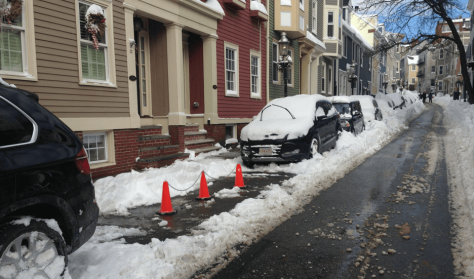 If the city can’t protect residents from people living in vehicles in front of their houses, residents who are dealing with street camping issues in their immediate areas, may need to take this matter into their own hands — for instance I’ve seen some people block off the space in the street front of their house with orange cones or folding signs. I hear that it’s common to do this with chairs in some cities. This is generally done to save parking spaces, not to block homeless people from living there, but new times and new problems may require that such “parking solutions” be used for these new problems.
If the city can’t protect residents from people living in vehicles in front of their houses, residents who are dealing with street camping issues in their immediate areas, may need to take this matter into their own hands — for instance I’ve seen some people block off the space in the street front of their house with orange cones or folding signs. I hear that it’s common to do this with chairs in some cities. This is generally done to save parking spaces, not to block homeless people from living there, but new times and new problems may require that such “parking solutions” be used for these new problems. 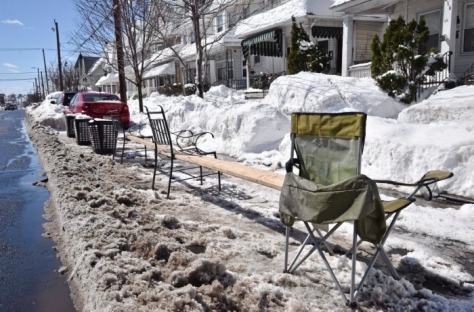
Some may opt to buy a 2nd vehicle and park it in front of their home themselves. Perhaps some new “parklets” such as we see in front of cafes in commercial areas will come into being. ,
As more people feel entitled to use public streets as campgrounds, either cities will have to adequately deal with this issue such that they can protect neighborhoods from being turned into slums, or perhaps we will see a rise in the blossoming of “undocumented” parklets and outdoor hangout spaces, appropriated from the same area of the public streets that the cities are apparently refusing to regulate. After all, if the city is saying someone can just drive up and reside in this space, why shouldn’t I be able to set up a little patio there, with attractive outdoor seating, or a nice little cafe area? How about a reading room or outdoor living room replete with a nice little “lending library”? And if the city wants everything sitting in a public street to be street legal and on wheels — well these little patios, living rooms and reading rooms can easily be built on standard utility trailers with valid licensing, registration and insurance.
After all, it’s far more attractive and fun to have a little outdoor seating area on the street in front of your house which fits in with the neighborhood, the yards and local flora and architecture, than to have an unfriendly family in a dingey RV living there and dumping buckets of urine on the street beside it.
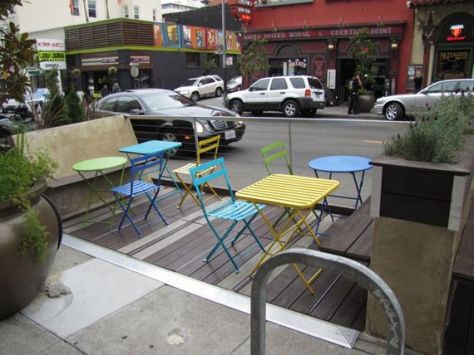
- what it looks like when we take back our streets

UPDATE October 17 2019
The problem of vehicle dwelling is just getting much worse in Oakland. It’s grown 131% in the last year, this article reports: https://www.sfchronicle.com/bayarea/article/Oakland-s-homeless-vehicle-dwellers-exploding-14539892.php
Which makes it clear that if a city tolerates this, normalizes vehicle dwelling, in essence makes room for it, then it will just get more and more of it. To put a stop to this out-of-control nuisance, Oakland and other cities need to enforce their existing laws that prohibit RV parking on streets overnight, and enforce laws that prohibit living in vehicles on public streets.


I discovered that it’s illegal for people to keep out of state license plates when they reside in a new state. They are required to get new registration in the state where they are living (or squatting, as the case may be).
One can report so called “cheaters” who dont’ get the in state registration as required, here:
https://www.chp.ca.gov/notify-chp/cheaters-out-of-state-(out-of-state-registration-violators)
I dont’ think the CHP walks on eggshells around the “homeless” as do Berkeley Police, so this may be a better way to go with problematic vehicle dwellers with out of state plates.
LikeLike
The main reason there are so many people living in RVs and other vehicles is due to decreased income, combined with previously-affordable housing rapidly escalating in price. Homes that were recently affordable are now far out of reach of most low-income workers. People from other states flock to warmer states like California and Florida if they can’t afford to live indoors. Combine this with the fact that many people who own multiple rental units have chosen to make them available for temporary, AirBnB types of programs in order to increase their profits, so these many thousands of units have vanished from the affordable housing market within a very short time, since there is virtually no regulation over this type of change for rental property owners.
Cities may create new laws, and this might force vehicle dwellers to alter their parking, but the real problem is not being addressed. Why are so many people suddenly being forced to give up their homes and live in vehicles just to survive day to day, hoping for something better to come along? These people certainly don’t have the means to create new jobs or financial opportunities on their own. And why are their fellow citizens turning against them for the sake of a better view, instead of reaching out and helping to solve the actual problems of lower wages and overpriced housing?
To be sure, there must be no animosity toward our fellow citizens for any reason beyond criminal behavior, and categorizing an entire group of people based on anecdotal “evidence” that can only be attributed to a few within the group is an abomination of social justice. These vehicle dwellers are not guilty of anything other than being on the receiving end of the unfortunate circumstance of being displaced by corporate policies and easily manipulated city leaders. Blame corporate greed for the loss of views and some extra litter, but don’t blame the victims of that greed.
LikeLike
I wouldn’t agree that most of those living in vehicles are there because housing has become unaffordable and they have no option of getting standard housing. It’s true that housing has become more expensive in this area, but it’s far less expensive in other areas, and even in expensive areas, there are options to bring down rent. People can double up, triple up in rooms to bring down the cost of rent. But if cities tolerate them to camp in the streets, why go to the trouble to work to find affordable housing? And more, as living in the streets becomes normalized, it becomes a “choice” that some comfortably housed people are making. I’ve met four individuals myself who had standard housing, and willingly gave that up — they were not evicted or priced out — in order to live in a vehicle on the streets. I believe a large part of why they made that choice is because this has become viewed, in fact, as a “free choice” and cities have tolerated it. Only ceasing to tolerate this choice will stop people from willingly going in this problematic reverse direction.
Also, I take issue with your assertion that the cause of the increased cost of housing is “greed.” As I’ve written about elsewhere at length, ( https://housingsolutions.home.blog/2019/06/14/need-more-housing-then-dont-expand-rent-control/ )
it’s far more accurate to say that government policy, including rent control, is responsible for driving up the cost of housing. As government continues to try to take away property owner’s rights, they will be less likely to rent out their property, and many units have thus been removed from the market or converted to short term rentals. As well, have you looked at the cost of property recently? I looked at one 4 unit building for sale in Berkeley. https://www.redfin.com/CA/Berkeley/Undisclosed-address-94705/home/1565501
It sells for $1,290,000, which with a standard loan, would result in monthly expenses of $7000. Yet the current “rent control” rents on the 4 units, are $873, $911, $2199 and $1973. or $5956 total. Hence the rents, which cannot be raised significantly per rent control laws, are not sufficient even to pay the owner’s basic monthly expenses. This means that no one can buy that property with a standard loan, and run a reasonable business. Hence that property will have to go to an all cash or mostly cash buyer, and small property owners are being priced out of the property rental business due to rent control. Rent controlled rents are just too low for the going price of property.
Finally, if you’ve paid any attention at all to the problem of vehicle dwelling in Berkeley, Oakland, San Francisco and other cities, you would know that the corresponding problems are about far more than “a better view”. There are drugs (masses of needles found near RV camping sites), garbage, human waste going into the streets, an increase in property crimes reported in some areas, scarcity of parking for those living or working in an area, intimidating or harassing behavior, inoperable vehicles leaking fluids, fire danger, and more. People living in vehicles on public streets is unacceptable for a number of reasons, and in the end, it doesn’t actually matter what caused them to end up there. This is not a viable “choice” for how to live and cities should not tolerate it.
LikeLike